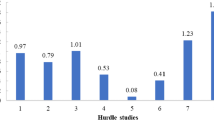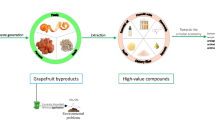Abstract
In this paper, we explored an innovative and sustainable technology to improve the sensorial characteristics of traditional sparkling wine. Different volumes of lees, recovered from the first fermentation, were included into the “liqueur de tirage” for the second fermentation of Bombino grapes base wine. Proteolysis evolution was compared to that of traditional Bombino grapes sparkling wine over 18 months after “dégorgement”, using combined liquid chromatography techniques and matrix-assisted laser desorption/ionization time-of-flight mass spectrometry analysis of peptides in the size of 1500–3000 Da range. The addition of lees exhibited a clear impact on proteolysis, most likely due to the hydrolytic enzymes released by yeast autolysis. The profile of volatile organic compounds was assessed by gas chromatography–MS, foam stability, and the sensory traits were both evaluated by a panel of trained testers. The sensory traits were positively influenced by the addition of lees up to 60 mL/L base wine. Therefore, changing the amount of lees addition can be used to modulate the aromatic composition of sparkling wine in an attempt to improve it, and this also allows the shortening of ageing time.







Similar content being viewed by others
References
Perez-Serradilla JA, de Castro MDL (2008) Role of lees in wine production: a review. Food Chem 111:447–456
Pozo-Bayò MA, Martinez-Rodriquez A, Pueyo E, Moreno-Arribas MV (2009) Chemical and biochemical features involved in sparkling wine production: from a traditional to an improved winemaking technology. Trends Food Sci Tech 20:1300–1306
Martínez-Rodríguez AJ, Carrascosa AV, Martín-Àlvarez PJ, Moreno-Arribas V, Polo MC (2002) Influence of the yeast strain on the changes of the amino acids, peptides and proteins during sparkling wine production by the traditional method. J Ind Microbiol Biotechnol 29:314–322
Martínez-Rodríguez AJ, Polo MC (2000) Characterization of the nitrogen compounds released during yeast autolysis in a model wine system. J Agr Food Chem 48:1081–1085
Moreno-Arribas V, Pueyo E, Nieto FJ, Martín-Àlvarez PJ, Polo MC (2000) Influence of the polysaccharides and the nitrogen compounds on foaming properties of sparkling wines. Food Chem 70:309–317
Dale CJ, Hough JS, Young TW (1986) Fractionation of high and low molecular weight components from wort and beer by adsorption chromatography using the gel sephadex LH20. J Inst Brew 92:457–460
Goristein S, Kitov S, Deutsch J (1980) Spectroscopic determination of glycerol, polyphenols and nitrogenous compounds in beer and wine. MBAA Tech Q 17:156
Bartolomé B, Moreno-Arribas V, Pueyo E, Polo MC (1997) Online HPLC photodiode array detection and OPA derivatization for partial identification of small peptides from white wine. J Agric Food Chem 45:3374–3381
Senée J, Robillard B, Vignes-Adler M (2001) The ζ-potential of the endogenous particles of a wine of Champagne in relation to the foaming behaviour. Colloids Surf B 21:59–67
de Person M, Sevestre A, Chaimbault P, Perrot L, Duchiron F, Elfakir C (2004) Characterization of low molecular weight peptides in champagne wine by liquid chromatography/tandem mass spectrometry. Anal Chim Acta 520:149–158
Liger-Belair G (2005) The physics and chemistry behind the bubbling properties of champagne and sparkling wines: a state-of-the-art. Rev J Agric Food Chem 53:2788–2802
Gougeon RD, Lucio M, Frommberger M, Peyron D, Chassagne D, Alexandre H, Feuillat F, Voilley A, Cayot P, Gebefügi I, Hertkorn N, Schmitt-Kopplin P (2009) The chemodiversity of wines can reveal a metabologeography expression of cooperage oak wood. Proc Natl Acad Sci USA 106:9174–9179
Liger-Belair G, Cilindre C, Gougeon RD, Lucio M, Gebefügi I, Jeandet P, Schmitt-Kopplin P (2009) Unraveling different chemical fingerprints between a champagne wine and its aerosols. Proc Natl Acad Sci USA 106:16545–16549
Coelho E, Reis A, Domingues MR, Rocha SM, Coimbra MA (2011) Synergistic effect of high and low molecular weight molecules in the foamability and foam stability of sparkling wines. J Agric Food Chem 59:3168–3179
Vincenzi S, Crapisi A, Curioni A (2014) Foamability of Prosecco wine: cooperative effects of high molecular weight glycocompounds and wine PR-proteins. Food Hydrocoll 34:202–207
Desportes C, Charpentier M, Duteurtre B, Maujean A, Duchiron F (2000) Liquid chromatography fractionation of small peptides from wine. J Chromatogr A 893:281–291
Maujean A, Poinsaut P, Dantan H, Brissonet F, Cossiez E (1990) Study of the performance and quality of the foam in sparkling wines. Bull OIV 63:405–427
Marchal R, Seguin V, Maujean A (1997) Quantification of interferences in the direct measurement of proteins in wines from the champagne region using the Bradford method. Am J Enol Vitic 48:303–309
Winther JR, Webb H, Kay J (2012) Aspartic peptidases. In: Barrett AJ, Woessner F, Rawlings ND (eds) Handbook of proteolytic enzymes, 3rd edn. Elsevier Academic Press, London
Rao MB, Tanksale AM, Ghatge MS, Deshpande VV (1998) Molecular and biotechnological aspects of microbial proteases. Microbiol Mol Biol Rev 62:3597–3635
Leroy MJ, Charpentier M, Duteurtre B, Feuillat M, Charpentier C (1990) Yeast autolysis during champagne aging. Am J Enol Vitic 41:21–28
Martínez-Rodríguez AJ, Polo MC, Carrascosa AV (2001) Structural and ultrastructural changes in yeast cells during autolysis in a model wine system and in sparkling wines. Int J Food Microbiol 71:45–51
Yang Y, Chien M (2000) Characterization of grape procyanidins using high-performance liquid chromatography/mass spectrometry and matrix-assisted laser desorption/ionization time-of-flight mass spectrometry. J Agric Food Chem 48:3990–3996
Péron N, Cagna A, Valade M, Bliard C, Aguié-Béghin V, Douillard R (2001) Layers of macromolecules at the champagne/air interface and the stability of champagne bubbles. Langmuir 17:791–797
Abdallah Z, Aguié-Béghin V, Abou-Saleh K, Douillard R, Christophe B (2010) Isolation and analysis of macromolecular fractions responsible for the surface properties in native champagne wines. Food Res Int 43:982–987
Abou-Saleh K, Aguié-Béghin V, Foulon L, Valade M, Douillard R (2007) Characterization by optical measurements of the effects of some stages of champagne technology on the adsorption layer formed at the gas/wine interface. Langmuir 23:7200–7208
Abou-Saleh K, Aguié-Béghin V, Foulon L, Valade M, Douillard R (2009) Relations between the air/wine adsorption layer and the bubble collar stability in experimental and commercial champagnes. Colloids Surf A 344:86–96
Pueyo E, Martinez-Alvarez AJ, Polo MC (1998) Relationship between foam characteristics and chemical composition in wines and cavas (sparkling wines). Am J Enol Vitic 46:518–524
Douillard R, Aguié-Beghin V (2011) Incidence des macromolécules sur la tenue de mousse d’un champagne. Rev Fr d’Oenol 246:20–26
Pozo-Bayò MA, Monagas M, Polo MC, Gòmez-Cordovés C (2004) Occurence of pyranoanthocyanins in sparkling wines manufacturing with red grape varieties. J Agric Food Chem 52:1300–1306
Riu-Aumatell M, Bosch-Fustè J, Lopez-Tamames E, Buxaderas S (2006) Development of volatile compounds of cava (Spanish sparkling wine) during long ageing time in contact with lees. Food Chem 95:237–242
Caridi A (2006) Enological functions of parietal yeast mannoproteins. Antonie Van Leeuwenhoek. Int J Gen Mol Microb 89:417–429
Etievant PX (1991) Wine. In: Maarse H (ed) Volatile compounds in food and beverage. Marcel Dekker Inc, New York
Bautista R, Fernandez E, Falque E (2006) Effect of the contact with fermentation-lees or commercial-lees on the volatile composition of white wines. Eur Food Res Technol 224:405–413
Bueno JE, Peinado RA, Medina M, Moreno J (2006) Effect of a short contact time with lees on volatile composition of Airen and Macabeo wines. Biotechnol Lett 28:1007–1011
Gallart M, Lopez-Tamames E, Suberbiola G, Buxaderas S (2002) Influence of fatty acids on wine foaming. J Agric Food Chem 50:7042–7045
Sumby KM, Grbin PR, Jiranek V (2010) Review. Microbial modulation of aromatic esters in wine: current knowledge and future prospects. Food Chem 121:1–16
Rodriguez-Nogales JM, Fernàndez-Fernàndez E, Gòmez M, Vila-Crespo J (2012) Antioxidant properties of sparkling wines produced with β-glucanases and commercial yeast preparations. Food Sci 77:1005–1010
Nunez YP, Carrascosa AV, González R, Polo MC, Martínez-Rodríguez AJ (2005) Effect of accelerated autolysis of yeast on the composition and foaming properties of sparkling wines elaborated by a champenoise method. J Agric Food Chem 53:7232–7237
Torresi S, Frangipane MT, Anelli G (2011) Biotechnologies in sparkling wine production. Interesting approaches for quality improvement: a review. Food Chem 129:1232–1241
Cebollero E, Gonzalez-Ramos D, Gonzalez R (2009) Construction of a recombinant autolytic wine yeast strain overexpressing the csc1-1 allele. Biotechnol Prog 25:1598–1604
Acknowledgments
We are grateful to D’Araprì winery (San Severo, FG, Apulian) for their collaboration.
Author information
Authors and Affiliations
Corresponding author
Ethics declarations
Conflict of interest
None.
Compliance with ethics requirements
This article does not contain any studies with human or animal subjects.
Rights and permissions
About this article
Cite this article
la Gatta, B., Picariello, G., Rutigliano, M. et al. Addition of lees from base wine in the production of Bombino sparkling wine. Eur Food Res Technol 242, 1307–1317 (2016). https://doi.org/10.1007/s00217-016-2634-z
Received:
Revised:
Accepted:
Published:
Issue Date:
DOI: https://doi.org/10.1007/s00217-016-2634-z




